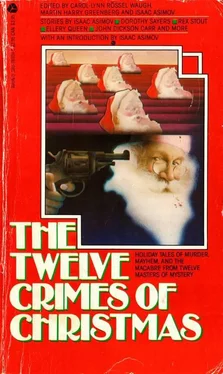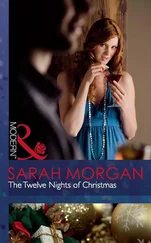Carol-Lynn Waugh - The Twelve Crimes of Christmas
Здесь есть возможность читать онлайн «Carol-Lynn Waugh - The Twelve Crimes of Christmas» весь текст электронной книги совершенно бесплатно (целиком полную версию без сокращений). В некоторых случаях можно слушать аудио, скачать через торрент в формате fb2 и присутствует краткое содержание. Жанр: Триллер, на английском языке. Описание произведения, (предисловие) а так же отзывы посетителей доступны на портале библиотеки ЛибКат.
- Название:The Twelve Crimes of Christmas
- Автор:
- Жанр:
- Год:неизвестен
- ISBN:нет данных
- Рейтинг книги:3 / 5. Голосов: 1
-
Избранное:Добавить в избранное
- Отзывы:
-
Ваша оценка:
- 60
- 1
- 2
- 3
- 4
- 5
The Twelve Crimes of Christmas: краткое содержание, описание и аннотация
Предлагаем к чтению аннотацию, описание, краткое содержание или предисловие (зависит от того, что написал сам автор книги «The Twelve Crimes of Christmas»). Если вы не нашли необходимую информацию о книге — напишите в комментариях, мы постараемся отыскать её.
The Twelve Crimes of Christmas — читать онлайн бесплатно полную книгу (весь текст) целиком
Ниже представлен текст книги, разбитый по страницам. Система сохранения места последней прочитанной страницы, позволяет с удобством читать онлайн бесплатно книгу «The Twelve Crimes of Christmas», без необходимости каждый раз заново искать на чём Вы остановились. Поставьте закладку, и сможете в любой момент перейти на страницу, на которой закончили чтение.
Интервал:
Закладка:
There is a law among storytellers, originally passed by Editors at the cries (they say) of their constituents, which states that stories about Christmas shall have Children in them. This Christmas story is no exception; indeed, misopedists will complain that we have overdone it. And we confess in advance that this is also a story about Dolls, and that Santa Claus comes into it, and even a Thief; though as to this last, whoever he was-and that was one of the questions-he was certainly not Barabbas, even parabolically.
Another section of the statute governing Christmas stories provides that they shall incline toward Sweetness and Light. The first arises, of course, from the orphans and the never-souring savor of the annual Miracle; as for Light, it will be provided at the end, as usual, by that luminous prodigy, Ellery Queen. The reader of gloomier temper will also find a large measure of Darkness, in the person and works of one who, at least in Inspector Queen’s harassed view, was surely the winged Prince of that region. His name, by the way, was not Satan, it was Comus; and this is paradox enow, since the original Comus, as everyone knows, was the god of festive joy and mirth, emotions not commonly associated with the Underworld. As Ellery struggled to embrace his phantom foe, he puzzled over this non sequitur in vain; in vain, that is, until Nikki Porter, no scorner of the obvious, suggested that he might seek the answer where any ordinary mortal would go at once. And there, to the great man’s mortification it was indeed to be found: On page 262b of Volume 6, Coleb to Damasci, of the 175th Anniversary edition of the Encyclopedia Britannica. A French conjuror of that name, performing in London in the year 1789, caused his wife to vanish from the top of a table-the very first time, it appeared, that this feat, uxorial or otherwise, had been accomplished without the aid of mirrors. To track his dark adversary’s nom de nuit to its historic lair gave Ellery his only glint of satisfaction until that blessed moment when light burst all around him and exorcised the darkness, Prince and all.
But this is chaos.
Our story properly begins not with our invisible character but with our dead one.
Miss Ypson had not always been dead; au contraire. She had lived for seventy-eight years, for most of them breathing hard. As her father used to remark, “She was a very active little verb.” Miss Ypson’s father was a professor of Greek at a small Midwestern university. He had conjugated his daughter with the rather bewildered assistance of one of his brawnier students, an Iowa poultry heiress.
Professor Ypson was a man of distinction. Unlike most professors of Greek, he was a Greek professor of Greek, having been born Gerasymos Aghamos Ypsilonomon in Polykhnitos, on the island of Mytilini, “where,” he was fond of recalling on certain occasions, “burning Sappho loved and sung”-a quotation he found unfailingly useful in his extracurricular activities; and, the Hellenic ideal notwithstanding, Professor Ypson believed wholeheartedly in immoderation in all things. This hereditary and cultural background explains the professor’s interest in fatherhood-to his wife’s chagrin, for Mr. Ypson’s own breeding prowess was confined almost exclusively to the barnyards on which her income was based; he held their daughter to be nothing less than a biological miracle.
The professor’s mental processes also tended to confuse Mrs. Ypson. She never ceased to wonder why, instead of shortening his name to Ypson, her husband had not sensibly changed it to Jones. “My dear,” the professor once replied, “you are an Iowa snob.”
“But nobody,” Mrs. Ypson cried, “can spell it or pronounce it!”
“This is a cross,” murmured Professor Ypson, “which we must bear with ypsilanti.”
“Oh,” said Mrs. Ypson.
There was invariably something Sibylline about his conversation. His favorite adjective for his wife was “ypsiliform,” a term, he explained, which referred to the germinal spot at one of the fecundation states in a ripening egg and which was, therefore, exquisitely à propos. Mrs. Ypson continued to look bewildered; she died at an early age.
And the professor ran off with a Kansas City variety girl of considerable talent, leaving his baptized chick to be reared by an eggish relative of her mother, named Jukes.
The only time Miss Ypson heard from her father-except when he wrote charming and erudite little notes requesting, as he termed it, lucrum -was in the fourth decade of his Odyssey, when he sent her a handsome addition to her collection, a terra-cotta play doll of Greek origin over three thousand years old which, unhappily, Miss Ypson felt duty-bound to return to the Brooklyn museum from which it had unaccountably vanished. The note accompanying her father’s gift had said, whimsically: “Timeo Danaos et dona ferentes.”
There was poetry behind Miss Ypson’s dolls. At her birth the professor, ever harmonious, signalized his devotion to fecundity by naming her Cytherea. This proved the Olympian irony. For, it turned out, her father’s philoprogenitiveness throbbed frustrate in her mother’s stony womb: even though Miss Ypson interred five husbands of quite adequate vigor, she remained infertile to the end of her days. Hence it is classically tragic to find her, when all passion was spent, a sweet little old lady with a vague if eager smile who, under the name of her father, pattered about a vast and echoing New York apartment, playing enthusiastically with dolls.
In the beginning they were dolls of common clay: a Billiken, a kewpie, a Kathe Kruse, a Patsy, a Foxy Grandpa, and so forth. But then, as her need increased, Miss Ypson began her fierce sack of the past.
Down into the land of Pharaoh she went for two pieces of thin desiccated board, carved and painted and with hair of strung beads, and legless-so that they might not run away-which any connoisseur will tell you are the most superb specimens of ancient Egyptian paddle doll extant, far superior to those in the British Museum, although this fact will be denied in certain quarters.
Miss Ypson unearthed a foremother of “Letitia Penn,” until her discovery held to be the oldest doll in America, having been brought to Philadelphia from England in 1699 by William Penn as a gift for a playmate of his small daughter’s. Miss Ypson’s find was a wooden-hearted “little lady” in brocade and velvet which had been sent by Sir Walter Raleigh to the first English child born in the New World. Since Virginia Dare had been born in 1587, not even the Smithsonian dared impugn Miss Ypson’s triumph.
On the old lady’s racks, in her plate-glass cases, might be seen the wealth of a thousand childhoods, and some riches-for such is the genetics of dolls-possessed by children grown. Here could be found “fashion babies” from fourteenth-century France, sacred dolls of the Orange Free State Fingo tribe, Satsuma paper dolls and court dolls from old Japan, beady-eyed “Kalifa” dolls of the Egyptian Sudan, Swedish birch-bark dolls, “Katcina” dolls of the Hopis, mammoth-tooth dolls of the Eskimos, feather dolls of the Chippewa, tumble dolls of the ancient Chinese, Coptic bone dolls, Roman dolls dedicated to Diana, pantin dolls which had been the street toys of Parisian exquisites before Madame Guillotine swept the boulevards, early Christian dolls in their crèches representing the Holy Family-to specify the merest handful of Miss Ypson’s Briarean collection. She possessed. dolls of pasteboard, dolls of animal skin, spool dolls, crab-claw dolls, eggshell dolls, cornhusk dolls, rag dolls, pine-cone dolls with moss hair, stocking dolls, dolls of bisque, dolls of palm leaf, dolls of papier-mâché, even dolls made of seed pods. There were dolls forty inches tall, and there were dolls so little Miss Ypson could hide them in her gold thimble.
Читать дальшеИнтервал:
Закладка:
Похожие книги на «The Twelve Crimes of Christmas»
Представляем Вашему вниманию похожие книги на «The Twelve Crimes of Christmas» списком для выбора. Мы отобрали схожую по названию и смыслу литературу в надежде предоставить читателям больше вариантов отыскать новые, интересные, ещё непрочитанные произведения.
Обсуждение, отзывы о книге «The Twelve Crimes of Christmas» и просто собственные мнения читателей. Оставьте ваши комментарии, напишите, что Вы думаете о произведении, его смысле или главных героях. Укажите что конкретно понравилось, а что нет, и почему Вы так считаете.












